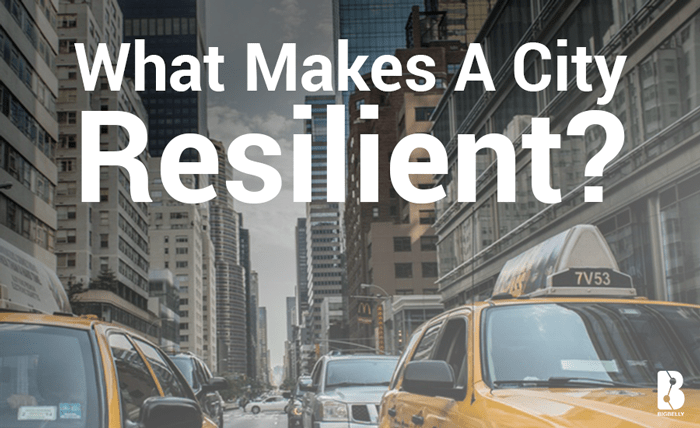As the world around us evolves due to changing economies, governments, natural resources, and the environment, municipalities may face strains on assets and resources. Cities and towns are proactively building strategies to limit the impact of acute shock and chronic stress that threaten them or weaken their foundation on a day-to-day or cyclical basis. Sudden, sharp events like disease outbreaks, national and international political and economic disruptions, terrorist accounts, and extreme weather and natural disasters such as earthquakes and floods are hard to deal with without proper pre-planning and disaster recovery plans in place. Stresses like inefficient public transportation systems; high unemployment; endemic violence; and power, food, and water shortages or interruptions also pose challenges for municipalities.
Efforts to build a Resilient City focus on planning today for tomorrow’s challenges. Future-proofing plans are designed to help municipalities withstand potential disasters and to operate self-sufficiently. Optimally, resilient city services are decentralized, networked, and locally supplied. The infrastructure is designed to withstand dramatic changes like prolonged periods of extreme temperatures, droughts, or floods.
Is your city or town built for resiliency?
According to Sustainable Cities Collective, some guidelines for making cities more resilient have been developed by the 100 Resilient Cities (100RC) program. The guidelines address anticipated shocks and stresses that if planned for properly allow a resilient city to better respond to the events and still deliver core services to residents, visitors, and businesses. The goal is to make cities more resilient to the physical, social, and economic challenges that are a growing part of the 21st century.
Today’s resilient cities reveal several qualities that allow them to withstand, respond to, and adapt quickly to shocks and stresses. 100RC notes that these cities are:
- Reflective: They use past experiences to inform future decisions.
- Resourceful: They recognize alternative ways to use resources.
- Robust: They maintain well-conceived, constructed, and managed systems.
- Redundant: They create spare capacity purposively to accommodate disruption.
- Flexible: They have a willingness and ability to adopt alternative strategies in response to changing circumstances.
- Inclusive: They prioritize broad consultation to create a sense of shared ownership in decision-making.
- Integrated: They bring together a range of distinct systems and institutions.
These qualities play out in the essentials for making cities resilient, including disaster resiliency. Efforts include assessment of institutional and administrative frameworks, as well as financing and other resources. Teams involved in determining a city’s resiliency also assess risk and evaluate current infrastructure and vital facilities – like hospitals and schools. Making a city more resilient also requires building regulations and land use planning; training, education and public awareness; environmental protection and strengthening of the city’s ecosystem; effective preparedness, early warning and response; and recovery and rebuilding plans.
Establishing programs and initiatives designed with city resiliency in mind include:
- Creating places of refuge.
- Building for higher rain flow, flood-proofing buildings.
- Providing shade — around buildings, in public spaces.
- Reducing vulnerability to wind damage, heavy snow fall.
- Stabilizing slopes susceptible to landslides, erosion, fire.
- Fortifying systems for outages — back-up power, heating/cooling and ventilation, water, lighting.
- Use of passive heating/cooling to minimize energy use.
- District heating, locally produced renewable energy.
- Establishing operations plans — emergency communications, protecting records/inventory, securing interior environments.
- Understanding needs of people (citizens and businesses) during crisis.
Today’s cities also focus the ”health’ of their transportation systems, evaluating and fortifying rapid transit bus, train and metro infrastructures and networks to prepare for possible crisis. Some cities consider bike-sharing programs, and evaluate foot traffic and walkability. Are streets well connected, footpaths well maintained, and pedestrian crossings and destinations well established?
Access to food is another area of focus for cities building resiliency programs. Ideally, cities seek easy access to locally grown food or community-supported agriculture. Supporting or establishing indoor growing as well as community growing programs and allotments are also viable components of resiliency planning initiatives.
With the proliferation of smart devices, cell phones in nearly everyone’s pockets, businesses needing access to the Internet, etc., reliable Internet access is needed. Cities are looking at the use of mesh network to deliver, robust Internet access even if every node in the network fails.
Criteria for Success
The Rockefeller Foundation, which manages the 100RC program, recognizes “four basic criteria for resilient cities – constant learning, the ability to rebound quickly from disaster, limitations and potential failures, and flexibility.” The 100RC also recommends the following as necessary requirements to developing a successful roadmap to resilience:
- Financial and logistical guidance for establishing an innovative new position in city government, a Chief Resilience Officer who will lead the city’s resilience efforts.
- Expert support for development of a robust resilience strategy.
- Access to solutions, service providers, and partners from the private, public and NGO sectors who can help them develop and implement their resilience strategies.
- Membership of a global network of member cities who can learn from and help each other.
As more municipalities join the city resiliency movement, the hope is that cities can help individual cities become more resilient – sharing lessons learned and best practices – and support the development of a global practice of resilience among governments, NGOs, the private sectors, and citizens.
Bigbelly Smart Waste & Recycling Products
- High Capacity Smart Waste Compactor ⮕
- Standard Capacity Smart Non-Compactor ⮕
- Multi-Modular Smart Waste Kiosk ⮕
- Telebelly Multipurpose Hosting Platform ⮕
- CLEAN Software Management Platform ⮕




